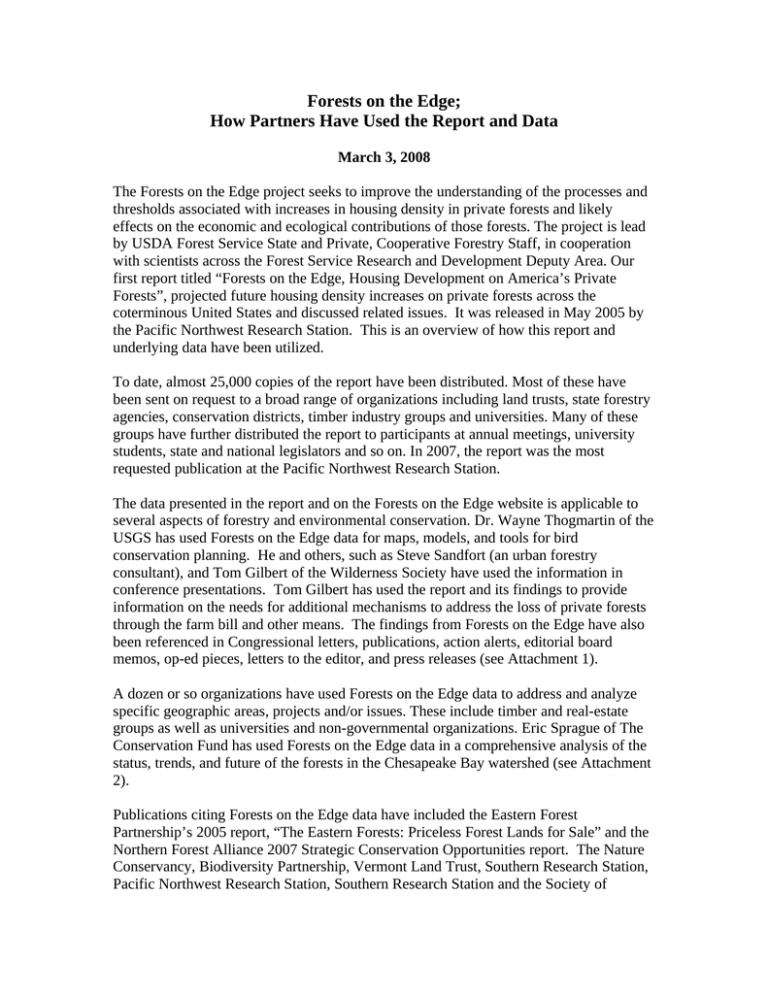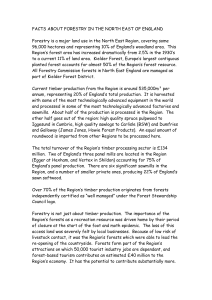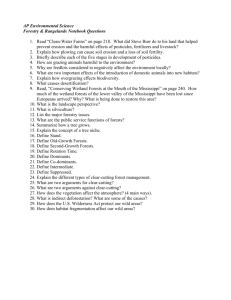Forests on the Edge;
advertisement

Forests on the Edge; How Partners Have Used the Report and Data March 3, 2008 The Forests on the Edge project seeks to improve the understanding of the processes and thresholds associated with increases in housing density in private forests and likely effects on the economic and ecological contributions of those forests. The project is lead by USDA Forest Service State and Private, Cooperative Forestry Staff, in cooperation with scientists across the Forest Service Research and Development Deputy Area. Our first report titled “Forests on the Edge, Housing Development on America’s Private Forests”, projected future housing density increases on private forests across the coterminous United States and discussed related issues. It was released in May 2005 by the Pacific Northwest Research Station. This is an overview of how this report and underlying data have been utilized. To date, almost 25,000 copies of the report have been distributed. Most of these have been sent on request to a broad range of organizations including land trusts, state forestry agencies, conservation districts, timber industry groups and universities. Many of these groups have further distributed the report to participants at annual meetings, university students, state and national legislators and so on. In 2007, the report was the most requested publication at the Pacific Northwest Research Station. The data presented in the report and on the Forests on the Edge website is applicable to several aspects of forestry and environmental conservation. Dr. Wayne Thogmartin of the USGS has used Forests on the Edge data for maps, models, and tools for bird conservation planning. He and others, such as Steve Sandfort (an urban forestry consultant), and Tom Gilbert of the Wilderness Society have used the information in conference presentations. Tom Gilbert has used the report and its findings to provide information on the needs for additional mechanisms to address the loss of private forests through the farm bill and other means. The findings from Forests on the Edge have also been referenced in Congressional letters, publications, action alerts, editorial board memos, op-ed pieces, letters to the editor, and press releases (see Attachment 1). A dozen or so organizations have used Forests on the Edge data to address and analyze specific geographic areas, projects and/or issues. These include timber and real-estate groups as well as universities and non-governmental organizations. Eric Sprague of The Conservation Fund has used Forests on the Edge data in a comprehensive analysis of the status, trends, and future of the forests in the Chesapeake Bay watershed (see Attachment 2). Publications citing Forests on the Edge data have included the Eastern Forest Partnership’s 2005 report, “The Eastern Forests: Priceless Forest Lands for Sale” and the Northern Forest Alliance 2007 Strategic Conservation Opportunities report. The Nature Conservancy, Biodiversity Partnership, Vermont Land Trust, Southern Research Station, Pacific Northwest Research Station, Southern Research Station and the Society of American Foresters have all cited Forests on the Edge data in publications and/or on websites. Many writers have included Forests on the Edge data in articles for journals, newspapers, and other publications. In March 2006, a Washington Post article entitled “Conservationists vie to buy forest habitat” cited the report’s major findings. John Rabb, a writer for the Bass Times, has used Forests on the Edge report in writing articles related to hunting, fishing and conservation. Jane Braxton Little, of Dyer Press, has used Forests on the Edge data in three different pieces. She stated that the report has helped her to quantify the issues (related to loss of open space) and translate numbers into human realities. The fact that the Forests on the Edge report and data has been utilized so extensively, indicates a real need for this type of information in an easy-to-read format. Cooperative Forestry Staff will continue to work with our colleagues in Research and Development to provide this type of information to our partners. For more information on Forests on the Edge, please go to: http://www.fs.fed.us/openspace/fote Or contact: Susan Stein, Forests on the Edge Project Manager, (202) 205-0837, sstein@fs.fed.us. Sara Comas, Forests on the Edge Assistant Manager, (202) 205-1572, scomas@fs.fed.us . Appendix A Users of Forests on the Edge Data The entries below represent a sample people that have used the Forests on the Edge data in their work. Wayne E. Thogmartin, PhD USGS Upper Midwest Environmental Sciences Center 2630 Fanta Reed Road La Crosse, WI 54603 608-781-6309 (off) 608-783-6066 (fax) wthogmartin@usgs.gov http://www.umesc.er.usgs.gov/terrestrial/migratory_birds/bird_conservation.html o o Uses mapping data from FOTE for maps, models and tools for bird conservation planning; Cited FOTE in slide talks on how development places bird species at risk . Mike Darr GIS Department Manager Forecon Inc. 1890 East Main St. Falconer NY 14733 (716) 664-5602 Ext310 http://www.foreconinc.com/ TIGERWeb(tm) Timber Inventory Growth Evaluation Reporting o Firm utilizes information for background data and justification for the development of ecosystem based capital markets specifically carbon sequestration markets for privately owned working forests. Steve Sandfort, Urban Forestry Consultant and Chairman for Board of Supervisors Mrtree-mu70@cinci.rr.com 513-631-3884 2654 Briarcliffe Ave. Cincinnati, Ohio o Has distributed it to chief arborist/forester for county park district (manages 25,000 acres) and staff of the Soil and Water Conservation District. John Rabb Bass Times, Senior Writer Burke, VA o Uses it for article ideas related to hunting, fishing, and conservation. Dennis Murphy o Using the FOTE data as part of an analysis of conservation opportunities in Idaho. o Working with a group of landowners and land trusts investigating market based incentives for land conservation. Part of this effort involves the preparation of background data on land use conversion o Used the FOTE data in a presentation, along with data from the American Farmland Trust, to communicate the conversion threat facing working farm, ranch and forestland. o Further application of the data to support prioritization of working lands is likely, but in preliminary stages. o The FOTE research is very relevant to my consulting work in land use and land economics, and encourage continued support of Phase II and similar efforts. o Jane Braxton Little Dyer Press Box D-201 Greenville, CA 95947 (530) 284-6516 o o o o o Freelance journalist; writes about forest issues June 2005 attended a conference sponsored by the Communities Committee of the Seventh American Forest Congress. Brought together community activists who are working to buy and manage private forests put on the market in the last decade. The conference stimulated her to write three separate stories about the loss of private forest lands across the country. o The first one appeared in American Forests, Fall 2005. o The second one expanded the issues dramatically and appeared in American Forests, Winter 2006. o Did additional research for the third story on this subject, which appeared in High Country News in January 2006. The second and third articles are both on her webpage ( www.dyerpress.com.). Forests on the Edge was extremely helpful in focusing on the acreage of forests being lost nationally. It also gave specifics about the highest rates of loss and generally helped quantify the issues. The emphasis on watershed and water quality put the losses in a context that downstream users could better appreciate. “That's helpful to a writer always trying to translate numbers into human realities.” About to appear on a panel that will look at these issues from a California perspective. o “I’m a year out of touch with the numbers so plan to return to Forest on the Edge to refresh my memory.” o “The loss of private timberlands is a major untold story. I've been pitching it to other publications and working with several to find the right angle for their readers. I am extremely interested in any updates you might be working on, or related publications.” Scott Klopfer GIS and Remote Sensing Division Coordinator Conservation Management Institute, VA Tech 1900 Kraft Drive Blacksburg VA (540) 231-8825 o Forests on the Edge data are used when writing/deciding on proposals and as substance in their work. Tom Gilbert Director, Eastern Forest Conservation The Wilderness Society 5 Spruce Farm 741 Grenoble RD. Jamison, PA 18929 (215) 343-1110 o The Wilderness Society and their coalition of partners in the Eastern Forest Partnership and the national LWCF Task Force have used the “excellent findings of the Forests on the Edge report extensively” in their work to inform others of the need for LWCF, the Forest Legacy program and for additional funding and mechanisms to help address the loss of private forests through the Farm bill. o The findings of this report have been incorporated into their communications on these issues including Congressional letters, publications, action alerts, editorial board memos, op-ed pieces, letters to the editor, press releases, etc. o “We greatly appreciate and value the excellent work of the Forests on the Edge Team. Please keep us posted regarding additional research that is in the works.” Samuel J. Radcliffe Prentiss & Carlisle 8301 N. Allen Lane Milwaukee, WI 53217 414.351.5202 o May use Forests on the Edge data in the future to help stratify timberland investment areas for their clients. Eric Sprague The Conservation Fund Chesapeake Bay o o The Conservation Fund collaborated with the USDA Forest Service to produce a comprehensive analysis of the status, trends, and future of forests in the Chesapeake Bay watershed. Forest on the Edge data was used to highlight the potential loss of forest to development by 2030. Angus Brodie Washington State Department of Natural Resources Land Management Division 1111 Washington St. SE PO BOX 47016 o May be using Forests on the Edge data in forest land planning process for state trust forest land in Washington State. Appendix B Examples of Publications Utilizing Forests on the Edge Information Society of American Foresters. 2005. Forest News. The E-Forester. 27 June 2005. http://www.safnet.org/members/eforester.cfm. (1 August 2007). Berman, Dan. 2005. 44 Million acres could be affected by development by 2030, Forest Service says. Land Letter. 23 June 2005. http://www.eenews.net/ll/. (1 August 2007). Berry, Bill. 2005. Decisions on land use issues crucial for future of state. Capital Times Web Edition. 20 September 2005. http://www.madison.com/tct/opinion/column/guest/index.php?ntid=54732&ntpid=2. (12 December 2005). Capitol Reports. 2005. Forest Service releases study showing loss of private forests to housing development. NewsLink Environmental. http://www.caprep.com/0605056.htm. (31 July 2007). Duncan, Leslie A. 2006. Nation’s forests face new pressures: Wall street. CQ Green Sheets: Forests. 15(8): 2-4. http://forestry.nacdnet.org/forestrynotes/Jul06/Forestry%20Notes-July%2006.pdf. (31 July 2007). Eastern Forest Partnership. 2005. Federal Studies Reveal Threats to Eastern Forests. The Eastern Forests: Priceless lands for sale. pp. 8. http://www.easternforest.org/resources/EFP_priceless_lands_for_sale.pdf. (31 July 2007). Eastern Forest Partnership. 2005. Forests for Life. The Eastern Forests: Priceless lands for sale. pp. 3. http://www.easternforest.org/resources/EFP_priceless_lands_for_sale.pdf. (31 July 2007). Forest Products Equipment. 2005. USDA: Without Intervention, 44 Million Acres of Forests may Vanish. http://www.fpemagazine.com/articles/44millionacres.html. (1 August 2007). Johnson, Kirk. 2007. As logging fades, Rich carve up open lands in West. New York Times. October 13 2007. Little, Jane B. 2006. Timberlands up for grabs. High County News. October 2006. pp. 9-13. http://www.oregon.gov/ODF/RESOURCE_POLICY/Forest_Policy_Issues_Newsletter_ October_2006.shtml#Timberlands_up_for_grabs. (31 July, 2007). Marshall, Patricia. 2006. Living on the edge. Forest Magazine. Winter 2006. http://www.fseee.org/forestmag/0801mars.shtml. (12 July 2007). McCabe, Richard. 2005. New forest service study: Can’t see private forests for the houses. Wildlife management institute. Outdoor News Bulletin 59(7): http://www.wildlifemanagementinstitute.org/News_Bulletin/05-07.cfm. (1 August 2007). Miller, Kevin. 2006. Corridor of conservation: Forest groups working to protect Lower Penobscot watershed from development pressures. Bangor News. June 8 2006. http://www.nature.org/wherewework/northamerica/states/maine/misc/art19579.html. (31 July 2007). Nichols, Dana M. 2007. New strategy aims to ensure future of forests. San Joaquin Record. December 17 2007. Northern Forest Alliance. 2007. Forests on the Edge: US Forest Service Predicts Significant Development Across Northern Forest. Strategic Conservation Opportunities. FY2007. pp.5. http://www.northernforestalliance.org/newspubs/pdfs/nfaFY07.pdf. (31 July 2007). Northern Forest Alliance. 2007. Upper Valley of the Connecticut River: Historic Watershed at Risk. Strategic Conservation Opportunities. FY2007. pp.12. http://www.northernforestalliance.org/newspubs/pdfs/nfaFY07.pdf. (31 July 2007). Pacific Northwest Research Station. 2006. For Further Reading. Science Finding. Issue 88: November 2006. pp. 5. http://www.fs.fed.us/pnw/sciencef/scifi88.pdf. (31 July 2007). Reese, April. 2005. Private lands pose challenge in reducing wildfire risk. Land Letter. 8 September 2005. http://www.eenews.net/ll/. (1 August 2007). Southern Research Station. 2005. Housing density increases on key southern watersheds. Compass. Fall 2005. http://www.srs.fs.usda.gov/compass/fall2005/03housingdensityrs.htm. (31 July 2007). The Biodiversity Partnership. 2005. Habitat and Forestland related publications. http://www.biodiversitypartners.org/habconser/forest/01.shtml. (31 July 2007). The Nature Conservancy. 2006. The Sale of the Century. Nature Conservancy: Our biggest deal ever. 56(3): pp. 20-25. The Nature Conservancy. 2007. Lower Penobscot Forest: Threatened habitat in Maine’s backyard. http://www.nature.org/wherewework/northamerica/states/maine/preserves/art19512.html. (31 July 2007). Urban Forestry South Expo. Resources: Forests on the Edge. http://www.urbanforestrysouth.org/Resources/Links/Link.2005-07-11.2223. (31 July 2007). Vermont Land Trust. 2005. More Background on the Conservation Issues: Why Conservation Can’t Wait. http://www.vlt.org/background.html. (12 December 2005).






